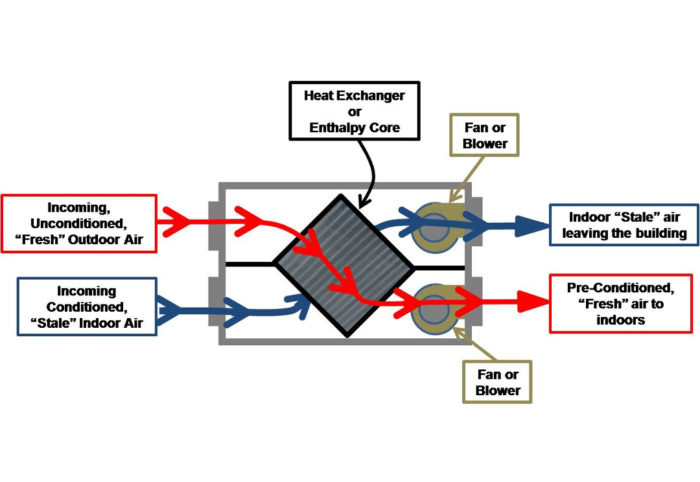How HRV Delivers a Comfortable Indoor Living Environment
Wiki Article
How Heat Recovery Ventilation Enhances Indoor Air Quality and Reduces Power Costs
Heat Recovery Ventilation (HRV) systems play a crucial role in improving interior air high quality while at the same time reducing power expenses. By effectively trading stagnant interior air with fresh outdoor air, HRVs aid maintain optimal moisture and minimize contaminants. Furthermore, their capacity to recover warmth from outbound air reduces the strain on heating and cooling systems. As energy expenses remain to climb, recognizing the full capacity of HRV systems comes to be significantly vital for property owners and companies alike.Understanding Heat Recovery Ventilation Systems

Heat recovery ventilation (HRV) systems play a crucial duty in improving indoor air top quality, especially in modern, energy-efficient buildings. These systems are designed to move heat from the outward bound stagnant air to the inbound fresh air, thus reducing power loss while maintaining ideal temperature level levels indoors. HRVs contain a warmth exchanger, followers, and ductwork, assisting in the continual circulation of air. By expelling indoor pollutants and introducing fresh air, HRVs help to stabilize moisture degrees, protect against mold and mildew growth, and minimize allergens. The efficiency of HRV systems depends on their ability to recuperate up to 80% of the warm from the worn down air, promoting power preservation while ensuring a healthy and balanced indoor atmosphere. Their combination is important in achieving sustainable living techniques.
The Value of Indoor Air High Quality
Indoor air quality (IAQ) is a critical aspect affecting the health and well-being of occupants in any kind of atmosphere. Poor IAQ can result in numerous health problems, including breathing troubles, allergies, and fatigue. Furthermore, it can aggravate current conditions such as asthma. Variables contributing to reduced IAQ include pollutants from interior sources like cleansing representatives, mold and mildew, and insufficient ventilation. As a result, maintaining great IAQ is essential for advertising a secure and comfy living or functioning area. Reliable methods to improve IAQ involve regular monitoring of air high quality, appropriate air flow systems, and decreasing making use of damaging materials inside your home. By focusing on IAQ, people can assure a much healthier environment that fosters productivity and overall quality of life.Energy Performance Benefits of HRV Systems
Numerous property owners and structure managers are significantly recognizing the energy effectiveness benefits of warmth healing air flow (HRV) systems. By transferring heat from tired indoor air to incoming fresh air, HRV systems markedly lower the power required for cooling and heating. This process lessens reliance on typical a/c systems, resulting in reduced energy costs. Furthermore, HRVs help keep a balanced indoor climate, stopping extreme home heating or cooling down needs. The capacity to recuperate up to 90% of the warm from outward bound air also supports sustainability initiatives by lowering overall energy usage. Consequently, HRV systems add not just to set you back financial savings however also to a lowered carbon footprint, aligning with the growing emphasis on energy-efficient building practices.Installment and Maintenance Considerations
The efficient implementation of warmth HRV Heat Recovery Ventilation recovery air flow (HRV) systems needs mindful consideration of installation and upkeep elements to guarantee peak performance. Proper positioning of the HRV device is crucial, as it should be installed in a location that optimizes air movement while lessening sound disruption. Additionally, ductwork must be suitably sized and protected to avoid power loss. Regular maintenance, consisting of filter substitute and system cleansing, is important to secure ideal performance and indoor air top quality. Owners should develop a normal upkeep routine to recognize and attend to potential problems before they rise. Collaboration with seasoned experts throughout both installation and upkeep stages can boost the longevity and efficiency of HRV systems, eventually causing far better indoor atmospheres and reduced energy prices.
Real-World Applications and Success Stories
Checking out real-world applications of heat healing ventilation (HRV) systems discloses their substantial effect on indoor air top quality and power efficiency throughout numerous settings. In residential buildings, homeowners have actually reported improved air quality, resulting in fewer allergies and breathing concerns. Schools executing HRV systems have kept in mind boosted student focus and lowered absenteeism as a result of far better air flow. Commercial structures, such as workplaces and retail spaces, have experienced reduced power prices and increased staff member performance. For example, a company office in a pleasant environment accomplished a 30% decrease in power expenses after installing an HRV system. These success tales demonstrate that HRV technology not just adds to much healthier settings yet also gives concrete monetary advantages, making it an important investment for different industries.Often Asked Questions
Can HRV Systems Decrease Irritants in Indoor Air?
The performance of HRV systems in decreasing interior allergens mostly depends upon their capability to filter and exchange air. HRV Heat Recovery Ventilation. By continually replacing stale air, these systems can greatly decrease allergen levels throughout interior atmospheres
How Does Moisture Affect HRV System Performance?
Moisture substantially influences HRV system efficiency; high levels can bring about condensation, decreasing performance, while reduced moisture might enhance air exchange. Balancing moisture is vital for ideal procedure and maintaining interior air top quality.Are HRV Solutions Noisy During Procedure?
HRV systems can create varying sound degrees during operation, depending on their layout and installment. Some units operate quietly, while others may create obvious audio, particularly at greater airflow settings or when poorly kept.What Is the Average Life-span of an HRV System?

Can HRV Equipments Be Made Use Of in All Climates?
HRV systems can be used in different environments, however their performance may vary - HRV Heat Recovery Ventilation. In extreme temperatures, changes or additional systems might be needed to assure optimal performance and comfort while maintaining interior air high qualityReport this wiki page